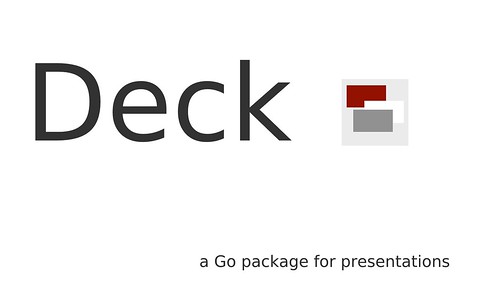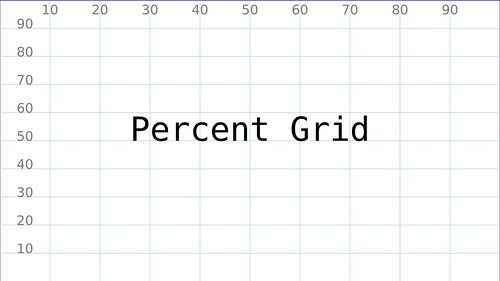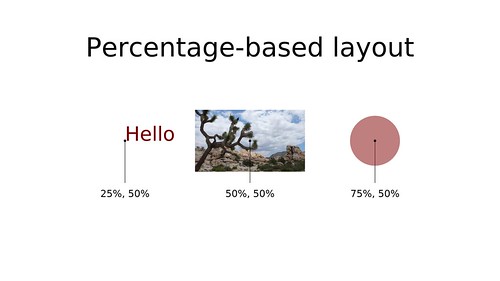ajstarks / Deck
Projects that are alternatives of or similar to Deck
deck: A Go package for slide decks
Deck is a library for clients to make scalable presentations, using a standard markup language. Clients read deck files into the Deck structure, and traverse the structure for display, publication, etc. Clients may be interactive or produce standard formats such as SVG or PDF.
Also included is a REST API for listing content, uploading, stopping, starting and removing decks, generating tables, and playing video.
The deck on Deck
Elements
- deck: enclosing element
- canvas: describe the dimensions of the drawing canvas, one per deck
- metadata elements: title, creator, publisher, subject, description, date
- slide: within a deck, any number of slides, specify the slide duration, background and text colors.
within slides any number of:
- text: plain, textblock, or code
- list: plain, bullet, number, centered
- image: JPEG or PNG images
- line: straight line
- rect: rectangle
- ellipse: ellipse
- curve: quadraticd Bezier curve
- arc: elliptical arc
- polygon: filled polygon
Markup
Here is a sample deck in XML:
<deck>
<title>Sample Deck</title>
<canvas width="1024" height="768"/>
<slide bg="maroon" fg="white" duration="1s">
<image xp="20" yp="30" width="256" height="256" name="picture.png"/>
<text xp="20" yp="80" sp="3" link="http://example.com/">Deck uses these elements</text>
<line xp1="20" yp1="75" xp2="90" yp2="75" sp="0.3" color="rgb(127,127,127)"/>
<list xp="20" yp="70" sp="1.5">
<li>canvas</li>
<li>slide</li>
<li>text</li>
<li>list</li>
<li>image</li>
<li>line</li>
<li>rect</li>
<li>ellipse</li>
<li>curve</li>
<li>arc</li>
</list>
<line xp1="20" yp1="10" xp2="30" yp2="10"/>
<rect xp="35" yp="10" wp="4" hp="3" color="rgb(127,0,0)"/>
<ellipse xp="45" yp="10" wp="4" hp="3" color="rgb(0,127,0)"/>
<curve xp1="60" yp1="10" xp2="75" yp2="20" xp3="70" yp3="10" />
<arc xp="55" yp="10" wp="4" hp="3" a1="0" a2="180" color="rgb(0,0,127)"/>
<polygon xc="75 75 80" yc="8 12 10" color="rgb(0,0,127)"/>
</slide>
</deck>
The list and text elements have common attributes:
xp: horizontal percentage
yp: vertical percentage
sp: font size percentage
lp: line spacing percentage
type: "bullet", "number" (list), "block", "code" (text)
align: "left", "middle", "end"
color: SVG names ("maroon"), RGB "rgb(127,0,0)" or hex ("#rrggbb")
font: "sans", "serif", "mono"
opacity: opacity percentage
rotation: (0-360 degrees)
link: url
See the example directory for example decks.
Layout
All layout in done in terms of percentages, using a coordinate system with the origin (0%, 0%) at the lower left. The x (horizontal) direction increases to the right, with the y (vertical) direction increasing to upwards. For example, to place an element in the middle of the canvas, specify xp="50" yp="50". To place an element one-third from the top, and one-third from the bottom: xp="66.6" yp="33.3".
The size of text is also scaled to the width of the canvas. For example sp="3" is a typical size for slide headings. The dimensions of graphical elements (width, height, stroke width) are also scaled to the canvas width.
The content of the slides are automatically scaled based on the specified canvas size (sane defaults are should be set the clients, if dimensions not specified)
Clients
example client
package main
import (
"fmt"
"log"
"github.com/ajstarks/deck"
)
func dotext(x, y, size float64, text deck.Text) {
fmt.Println("\tText:", x, y, size, text.Tdata)
}
func dolist(x, y, size float64, list deck.List) {
fmt.Println("\tList:", x, y, size)
for i, l := range list.Li {
fmt.Println("\t\titem", i, l)
}
}
func main() {
presentation, err := deck.Read("deck.xml", 1024, 768) // open the deck
if err != nil {
log.Fatal(err)
}
for slidenumber, slide := range presentation.Slide { // for every slide...
fmt.Println("Processing slide", slidenumber)
for _, t := range slide.Text { // process the text elements
x, y, size := deck.Dimen(presentation.Canvas, t.Xp, t.Yp, t.Sp)
dotext(x, y, size, t)
}
for _, l := range slide.List { // process the list elements
x, y, size := deck.Dimen(presentation.Canvas, l.Xp, l.Yp, l.Sp)
dolist(x, y, size, l)
}
}
}
Currently there are four clients: pdfdeck, pngdeck, svgdeck and vgdeck.
For PDF decks, install pdfdeck:
go get github.com/ajstarks/deck/cmd/pdfdeck
pdfdeck produces decks in PDF corresponding to the input file:
pdfdeck deck.xml
produces deck.pdf
For SVG decks, install svgdeck:
go get github.com/ajstarks/deck/cmd/svgdeck
This command:
svgdeck deck.xml
produces one slide per SVG file, with each slide linked to the next.
For png decks, install pngdeck:
go get github.com/ajstarks/deck/cmd/pngdeck
This command:
pngdeck deck.xml
makes one image per slide, numbered like deck-00001.png
vgdeck is a program for showing presentations on the Raspberry Pi, using the openvg library. To install:
go get github.com/ajstarks/deck/cmd/vgdeck
To run vgdeck, specify one or more files (marked up in deck XML) on the command line, and each will be shown in turn.
vgdeck sales.xml program.xml architecture.xml
Here are the vgdeck commands:
- Next slide: +, Ctrl-N, [Return]
- Previous slide, -, Ctrl-P, [Backspace]
- First slide: ^, Ctrl-A
- Last slide: $, Ctrl-E
- Reload: r, Ctrl-R
- X-Ray: x, Ctrl-X
- Search: /, Ctrl-F
- Save: s, Ctrl-S
- Quit: q
All commands are a single keystroke, acted on immediately (only the search command waits until you hit [Return] after entering your search text) To cycle through the deck, repeatedly tap [Return] key
DECKFONTS
pdfdeck and pngdeck use the DECKFONTS environment variable as the location of font files. Choose a directory for your fonts, say $HOME/deckfonts, and set the DECKFONTS environment variable to this directory. Note that the repository at github.com/ajstarks/deckfonts contains a set of fonts (Times, Helvetica, Courier, Zapf Dingbats, Charter, Fira, Go, IBM Plex, and Noto) for you to use:
export DECKFONTS=$HOME/deckfonts
cd $HOME
git clone https://github.com/ajstarks/deckfonts
...
pdfdeck foo.xml # (use helvetica as the default)
pdfdeck -sans NotoSans-Regular -serif NotoSerif-Regular -mono NotoMono-Regular foo.xml # specify fonts
Alternatively you can manually install fonts from the gofpdf package: (these instructions assume you installed gofpdf in your GOPATH.)
mkdir $HOME/deckfonts # make the DECKFONTS directory
export DECKFONTS=$HOME/deckfonts # you should make this permanent in your shell startup
cp $GOPATH/src/github.com/jung-kurt/gofpdf/font/*.json $DECKFONTS
In general you can place TrueType files obtained from anywhere in your DECKFONTS directory and then you can use them with pdfdeck: For example, the gofpdf package has DejaVu fonts:
cp $GOPATH/src/github.com/jung-kurt/gofpdf/font/DejaVu*.ttf $DECKFONTS
pdfdeck -sans DejaVuSansCondensed foo.xml
Also, to use the Go fonts:
cd $HOME
mkdir gofonts
cd gofonts
git clone https://go.googlesource.com/image
cp image/font/gofont/ttfs/*.ttf $DECKFONTS
...
pdfdeck -sans Go-Regular -mono Go-Mono foo.xml
you can also manually set the font directory via command line option:
pdfdeck -fontdir $GOPATH/src/github.com/jung-kurt/gofpdf/font foo.xml
API
The command deckd is a server program that provides an API for slide decks.
The API supports deck start, stop, listing, upload, and remove. Responses are encoded in JSON.
To install:
go get github.com/ajstarks/deck/cmd/deckd
Command line options control the working directory and address:port
-port Address:port (default: localhost:1958)
-dir [name] working directory (default: ".")
-maxupload [bytes] upload limit
GET / lists the API
GET /deck lists information on content, (filename, metadata (number of slides or image dimensions), modification time) in JSON
GET /deck?filter=[type] filter content list by type (std, deck, image, video)
POST /deck/file.xml?cmd=[duration] starts up a deck; the deck, duration, and process id are returned in JSON
POST /deck/file.xml?slide=[number] start at the specified slide
POST /deck?cmd=stop stops the running deck
DELETE /deck/file.xml removes a deck
PUT or POST to /upload uploads the contents of the Deck: header to the server
POST /table with the content of a tab-separated list, creates a slide with a formatted table, the Deck: header specifies the resulting deck file
POST /table/?textsize=[size] -- specify the text size of the generated table
POST /media plays the media file specified in the Media: header
The command deck is a command line interface to the deck Web API. Install it like this:
go get github.com/ajstarks/deck/cmd/deck
$ deck
Usage:
List: deck list [image|deck|video]
Play: deck play file [duration] [start-slide]
Stop: deck stop
Upload: deck upload files...
Remove: deck remove files...
Video: deck video file
Table: deck table file [textsize]
The shell script version of the command is in deck.sh. This version uses gttp (go get github.com/dgryski/gttp) to make HTTP requests.



